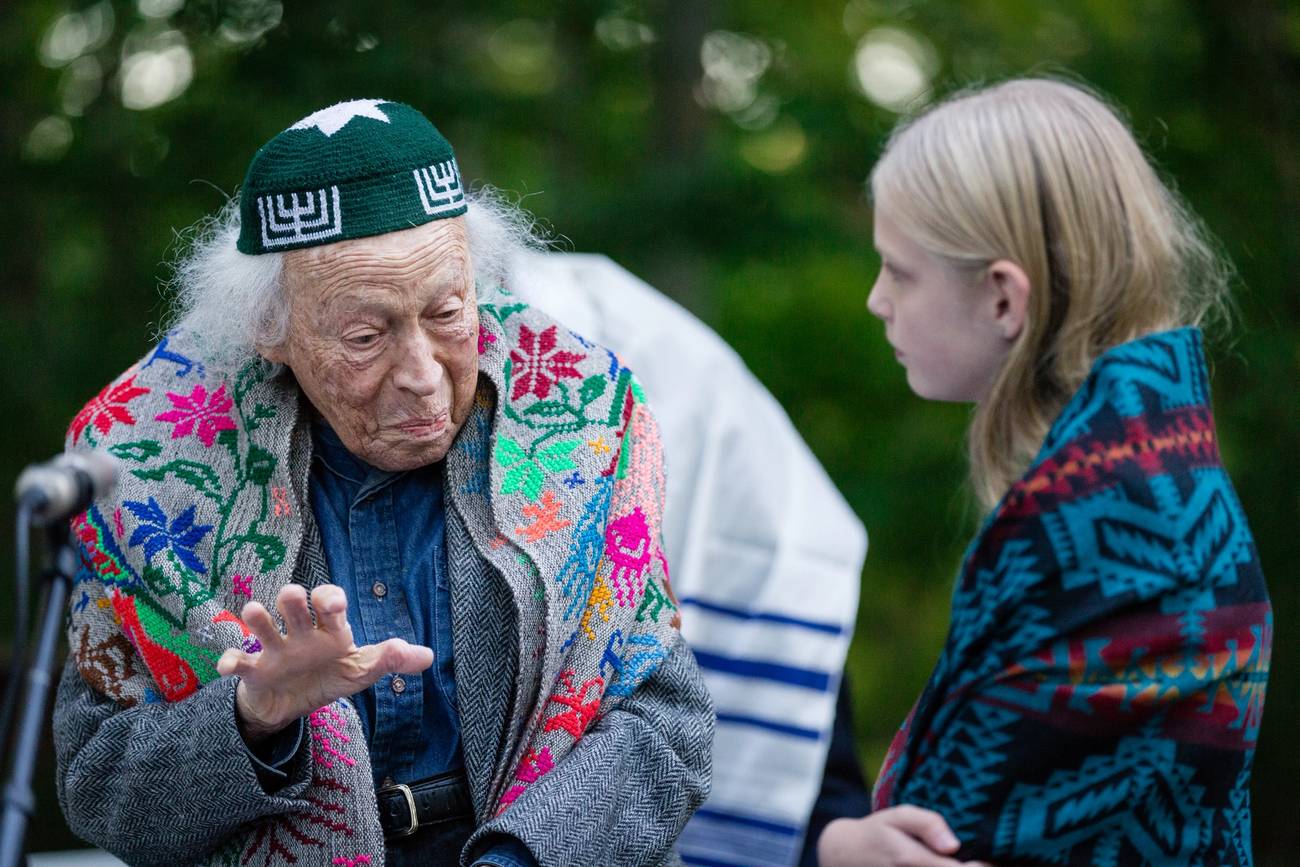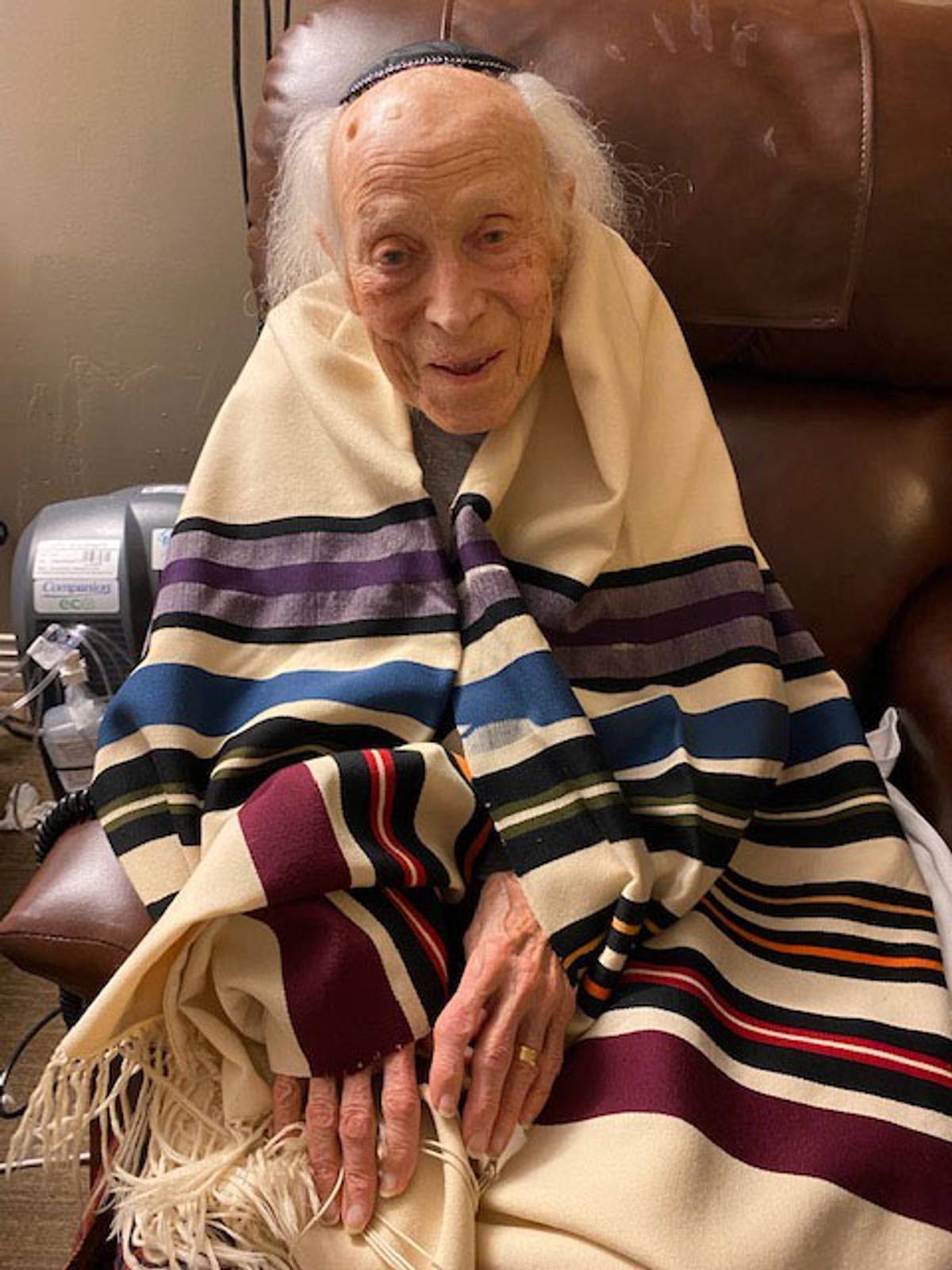A Tallit of Many Colors
At my son’s bar mitzvah, carrying on a tradition that honors experimentation and radical change



When my son is called to the Torah for his bar mitzvah in May, he will not wear the universally recognizable and traditional black-and-white tallit. His prayer shawl will be teal, with rows of gold, red, and orange diamonds, separated by black bands and small yellow triangles. Wearing a colorful tallit is not that uncommon these days, at least among non-Orthodox denominations—thanks to my uncle Everett’s friend Rabbi Zalman Schachter-Shalomi (1924-2014), who upended the black-and-white tradition in the 1960s.
I’ve always known, and taken for granted, that my uncle, Rabbi Everett Gendler, would show up to his temple in Massachusetts in a unique prayer shawl. His eclectic tallitot are all beautiful, but, more importantly, each comes with a story. He owns about a half-dozen, and while he does rotate them, he admits, “I have three favorites, and the others I like less.” His preferred tallitot include one he made using a flower-embroidered fabric he’d bought in Chiapas, Mexico, a traditional white tallit with black stripes that belonged to his father, and one with rainbow-colored stripes, also known as a “B’nai Or tallis.” The others, he quipped, are “fine, but some are made from synthetic materials.”
I grew up across the country in the Midwest and attended a classical Reform synagogue. Save for the rabbis, the cantor, and a few devout congregants, I rarely saw anyone covering their heads with a yarmulke, let alone wearing a tallit. I didn’t wear one at my bat mitzvah. Due to my lack of exposure to tallitot in general, I didn’t understand that my uncle was part of any new or radical change in tradition. And while I knew Uncle Everett was a leader in social justice and environmental causes, by doing things such as marching with Martin Luther King Jr. and inventing the solar eternal light, it wasn’t until I was older that I realized the extent to which he engaged in experimenting with how Judaism is practiced, or that he worked with others who did the same.
Schachter-Shalomi was a brilliant rabbi who experimented with how Judaism could be observed and experienced—and one of my uncle’s longtime friends and colleagues. According to Sharon Strassfeld, who co-wrote the groundbreaking how-to guide The Jewish Catalog in 1973, “Zalman’s knowledge of Jewish tradition was so deep he could push the boundaries in ways others didn’t think they could.” And, that’s exactly what he did with the tallit.
Before the 1960s, tallitot were white with black (or sometimes blue) stripes. This was not a requirement, but it’s just how tallitot were made, and no one veered from that. In the 1960s, people started experimenting with the traditions, while still adhering to the rules. According to an interview conducted by Rabbi Yonassan Gershom, “Reb Zalman was meditating on the Midrash: ‘How did G-d create the world? He wrapped Himself in a robe of light, and it began to shine.’” This meditation resulted in him envisioning and then designing the rainbow tallit. Strassfeld summarized, “Understanding that choosing a color other than white for a tallit was entirely permissible, Zalman explored using kabbalistic imagery to transform the meaning of the stripes on the tallit he designed.” While Gershom’s article details the pattern’s complexity, the basics are that the tallit’s colors represent the seven days of creation: deep purple for the first day and coming out of darkness; blue for water; green for vegetation; yellow for the sun, moon, and stars; orange for the egg-laying animals; red for the placental animals; and brown for the Earth.
After Schachter-Shalomi designed his new rainbow tallit, he had five made. According to Gershom, Schachter-Shalomi kept one, and he distributed three to his friends: my uncle Everett, Rabbi Arthur Green, and the renowned Rabbi Abraham Joshua Heschel, who was also Uncle Everett’s mentor and teacher. Gershom told me that Schachter-Shalomi didn’t indicate to whom he gave the fifth tallit, but I’ve learned that he gave it to one of his younger colleagues, Rabbi Neal Rose. For Green, it was the first non-white-and-black tallit he had ever seen. As he and the other rainbow tallit recipients were active, and as they became increasingly known in modern Jewish life, the tallitot they wore did as well. Schachter-Shalomi worked with thousands of kids at a popular summer camp in New England, and he created the Jewish Renewal movement. Green founded Havurat Shalom and taught at both the Reconstructionist Rabbinical College and Hebrew College. Rose taught at the University of Manitoba and has served in various communal rabbinic roles. Heschel famously wrote about social justice, participated in the civil rights movement, and taught at the Jewish Theological Seminary. And, my uncle was a congregational rabbi, a teacher at Phillips Academy Andover, and a prominent member of the social justice and environmental movements. Although these rabbis followed different paths, they shared an overarching principle: to get to the heart of Judaism’s core teachings and then make them intimate and meaningful for others in creative ways.
“These five tallaysim,” Gershom wrote, “opened the door for Jews everywhere to begin personalizing their prayer shawls and expressing their own visions of Jewish spiritual renewal.” My uncle Everett offered me a similar explanation. “Putting on the tallit is a profound symbolic act,” he said. “You are draping yourself in the divine light. That is powerful, and it carries with it both in relation to the divine in the moment along with a great trail of associations with the past. It is one of the most powerful of acts. Zalman refracted the divine light into colors of the rainbow.”
In the time between my own bat mitzvah in 1988 and the b’nai mitzvah services of my children and those of my friends and cousins, I’ve noticed a change in the Jewish coming-of-age ceremony. No matter the denomination, almost every b’nai mitzvah now receives a tallit. And the tallitot aren’t just white with black stripes, they are bright and colorful, and parents proudly explain why they chose that particular tallit. These tallitot largely resemble the ones Uncle Everett dons.
After attending college and marrying, I moved to Pittsburgh and joined a very different Jewish community than the one in which I grew up. Kesher Pittsburgh, led by Kohenet Keshira haLev Fife, is an independent, post-denominational community, which gathers people around their shared interest in enlivening Judaism at the intersection of spirituality and social justice. Fife wears a tallit, following in the footsteps of women like Strassfeld, who refashioned tradition when she started wearing one in 1972. While Strassfeld was not the first woman to wrap herself in a tallit, she was an early adopter. Her explanation feels apt to me, even now. “I was mighty uncomfortable for the first year or so,” she explained, “but I just kept at it until I felt uncomfortable without one.”

The tallit my son will wear at his bar mitzvah is similar to the one we made for our daughter—and is not just a prayer shawl, but also a symbol. My husband, who is not Jewish, had previously observed that the tallit reminded him of a blanket ceremony, like the ones he’d learned about from his Choctaw grandfathers and during his childhood on the Coeur d’Alene Indian Reservation. My husband explained that many indigenous tribes have coming-of-age ceremonies when the whole family gathers to honor the child, draping them in a blanket. Several Native American friends assisted us and, eventually, helped us find the perfect medium. For our tallitot, we are using cloth from Pendleton, a popular Oregon-based textile supplier for Native American products.
One issue remained for me. Would my children’s tallitot really be considered tallitot, according to Jewish law? I called Uncle Everett. He assured me that as long as I included the required elements (e.g., a four-cornered fabric with attached special fringes knotted to make the tzitzit), I could use any design I want.
This past Rosh Hashanah, Kohenet Fife’s partner, Tim Fife, delivered a sermon that encapsulated my view of a colorful tallit and how its evolution is relevant today. He discussed Genesis and how new beginnings and traditions start. He talked about COVID-19 and the novel activities that have resulted from this collective experience. He reflected that services moved online or outside and wondered if future generations sitting at their computers or in a park would think that this is how things have always been, or if they’ll recognize that there was a catalyst that resulted in that activity. Many of the things we do and take for granted—like colorful tallitot—only exist because someone was creative and brave and made a tradition their own and personally meaningful. When my son stands before the Torah in a tallit that is uniquely his, he will be carrying on tradition, both old and new, just as our daughter did before him.
Emily Loeb is the executive director of The Gendler Grapevine Project and founder of Shattering Glass Ceilings Scholarship. She lives in Pittsburgh and is writing a book about Rabbi Everett Gendler.